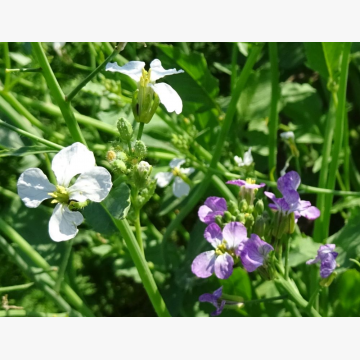- Home
- Seeds
- Catch/Cover crops
- Plants for catch/cover crops
- Fodder radish REAKTION KWS
FOR CONSULTATIONS APPLY TO:
Commercial director
Lina Smalskienė
tel. +370 618 02 551
e-mail linak@agrolitpa.lt
Sales manager
Tautvydas Kliučininkas
tel. +370 681 35 093
e-mail tautvydask@agrolitpa.lt
Sales manager
Eglė Petkevičienė
tel. +370 626 95 458
e-mail eglep@agrolitpa.lt
Sales manager
Kotryna Nakrošytė
tel.: +370 601 39 282
e-mail kotryna@agrolitpa.lt
Fodder radish REAKTION KWS
A mid-late diploid fodder radish, 1st class of resistance to beet cyst nematodes
- High biomass building at early growth stage
- Good soil covering ability
- Short plant length
- Good lodging resistance
- Suitable for biomass and seed production
- Initial mass formation – very fast (7 points out of 9 (where 9 is very high))
- The plants are not tall
- Covers the soil surface very well
- Tendency to flower – (4 points out of 9 (where 9 is very high))
- Flowering time – moderately late
- Tendency to lodging – low (4 points out of 9 (where 9 is very high))
- 1000 seed weight – 9.8 g
- Suitable for biomass and seed production
- Very resistant to Beet Cyst Nematode (BCN) (Heterodera schachtii) – 1 point out of 9 (where 1 is very resistant)
- Susceptibility to nematodes – score 1 (where 1 is very low, 8 is strong)
- Soil cover rate – 7 points (where 1 is very slow, 8 is very fast primary growth)
- Flowering time – 4 points (where 1 is very late, 8 is very early)
- Susceptibility to lodging – 4 points (where 1 is non-dormant plants, 8 is very sensitive to lodging)
*Bundessortenamt data
- Biomass formation at the beginning of growth – 7.5 points (where 9 is very good)
- Soil coverage – 8.1 points (where 9 is very good)
- Lodging – 2.9 points (where 9 is very high)
- Flowering – 48 BBCH
- Vegetative development – 62 BBCH
- Plant height – 95 cm
*2015-2016 according to data of trials at Bundessorenamt, Germany
- Flowers – 50 % white, 50 % purple
- 1000 seed weight – medium (5 points)
- Number of seeds in pods – medium (5 points)
- Roots – white
*According to UPOV research data
The varietal parameters may differ from those indicated here when the testing circumstances differ from quondam
Recommended sowing rate when growing for seed production: 10-14 kg/ha, interrow spacing – 12-15 cm
Recommended sowing rate when growing for green manure: 25-30 kg/ha
Keravos sreet. 17, Kerava,
LT-38 131 Panevėžys district, LITHUANIA
Enterprise's code 168598128
VAT code LT685981219
Tel. +370 615 11 315
E. mail info@agrolitpa.lt




.JPG)

